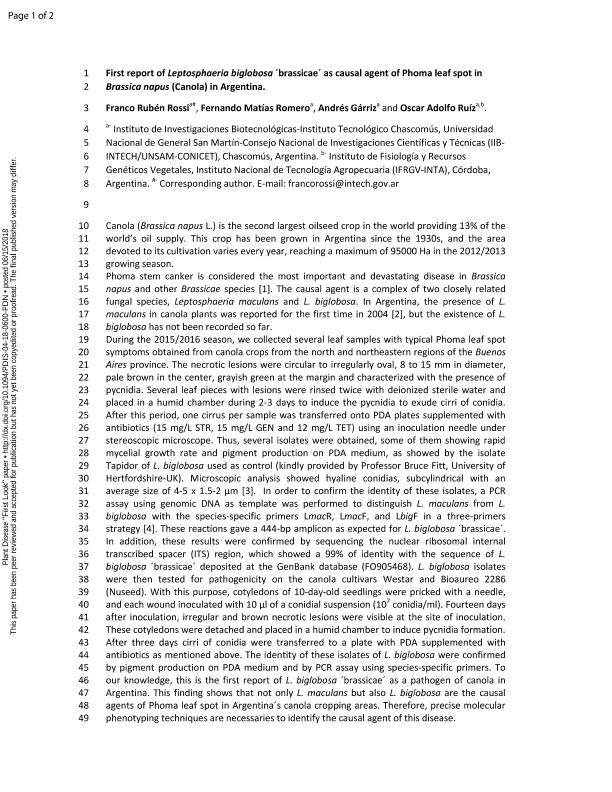Mostrar el registro sencillo del ítem
dc.contributor.author
Rossi, Franco Rubén

dc.contributor.author
Romero, Fernando Matias

dc.contributor.author
Garriz, Andrés
dc.contributor.author
Ruiz, Oscar Adolfo

dc.date.available
2020-03-25T13:34:40Z
dc.date.issued
2018-05
dc.identifier.citation
Rossi, Franco Rubén; Romero, Fernando Matias; Garriz, Andrés; Ruiz, Oscar Adolfo; First report of Leptosphaeria biglobosa ‘brassicae’ as causal agent of phoma leaf spot in Brassica napus (Canola) in Argentina; American Phytopathological Society; Plant Disease; 102; 12; 5-2018; 2647-2648
dc.identifier.issn
0191-2917
dc.identifier.uri
http://hdl.handle.net/11336/100647
dc.description.abstract
Canola(Brassicanapus L.) is the second largest oilseed crop in the worldproviding 13% of the world´s oil supply. This crop has been grown in Argentinasince the 1930s, and the area devoted to its cultivation varies every year,reaching a maximum of 95000 Ha in the 2012/2013 growing season. Because of theoccurrence of optimal weather conditions and soils with high fertility, theaverage yield in this region is about 2000 kg/Ha. Phoma leaf spot and Phomastem canker are considered the most important and devastating diseases in Brassica napus andother Brassicaespecies [1]. In both cases, the causal agent is a complexof two closely related fungal species, Leptosphaeria maculans and L. biglobosa. In Argentina,the presence of L. maculans incanola plants was reported for the first time in 2004 [2], but the existence ofL.biglobosa has not been recorded so far. During the 2015/2016season, we collected several samples with typical Phoma leaf spot symptoms fromcanola plants growing in fields from the north and northeastern regions of the Buenos Aires province.The necrotic lesions were circular to irregularly oval, 8 to 15 mm in diameter,pale brown in the center, grayish green at the margin and characterized withthe presence of pycnidia. Several leaf pieces with lesions were rinsed twicewith deionized sterile water and placed in a humid chamber (90 mm diameterPetri dish with a layer of filter paper soaked in deionized sterile water) during2-3 days to induce the pycnidia to exude cirri of conidia. After this period,one cirrus per sample was transferred onto PDA plates supplemented withantibiotics (15 mg/L streptomycin, 15 mg/L gentamicin and 12 mg/L tetracycline)using an inoculation needle under stereoscopic microscope. Thus, severalisolates were obtained, some of them showing rapid mycelial growth rate andpigment production on PDA medium, as showed by the isolate Tapidor of L. biglobosa thatwe used as control (kindly provided by Professor Bruce Fitt, University ofHertfordshire-UK). In order to confirm the identity of these isolates, a PCRassay using genomic DNA as template was performed to distinguish L. maculans from L. biglobosa withthe species-specific primers LmacR, LmacF,and LbigF ina three-primers strategy described by Gaetan (2005)[3]. These reactions gave a444-bp amplicon as expected for L. biglobosa ´brassicae´.In addition, these results were confirmed by sequencing the nuclear ribosomalinternal transcribed spacer (ITS) region, which showed a 99% of identity withthe sequence of L. biglobosa ´brassicae´at the GenBank database (FO905468). L. biglobosa isolateswere then tested for pathogenicity on the canola cultivars Westar and Bioaureo2286 (Nuseed). With this purpose, cotyledons of 10-day-old seedlings werepricked with a needle, and each wound inoculated with 10 μl ofa conidial suspension (107 42conidia/ml). Sterilized distilled water was used as control. Developing primaryleaves were removed every 2-3 days in order to ensure that cotyledons continueto expand. Fourteen days after inoculation, irregular and brown necroticlesions were visible at the site of inoculation. These cotyledons were detachedand placed in a humid chamber to induce pycnidia formation. After three dayscirri of conidia were transferred to a plate with PDA supplemented with antibioticsas mentioned above. The identity of these isolates of L. biglobosa wereconfirmed by pigment production on PDA medium and by PCR assay usingspecies-specific primers. To our knowledge, this is the first report of L. biglobosa ´brassicae´as a pathogen of canola in Argentina. This finding shows that in Argentina´scanola cropping areas not 50 only L. maculans but alsoL.biglobosa are the causal agents of Phoma leaf spot disease.
dc.format
application/pdf
dc.language.iso
eng
dc.publisher
American Phytopathological Society

dc.rights
info:eu-repo/semantics/openAccess
dc.rights.uri
https://creativecommons.org/licenses/by-nc-sa/2.5/ar/
dc.subject
PHOMA
dc.subject
LEPTOSPHAERIA BIGLOBOSA
dc.subject
BRASSICA NAPUS L.
dc.subject
PCR ASSAY IDENTIFICATION
dc.subject.classification
Micología

dc.subject.classification
Ciencias Biológicas

dc.subject.classification
CIENCIAS NATURALES Y EXACTAS

dc.title
First report of Leptosphaeria biglobosa ‘brassicae’ as causal agent of phoma leaf spot in Brassica napus (Canola) in Argentina
dc.type
info:eu-repo/semantics/article
dc.type
info:ar-repo/semantics/artículo
dc.type
info:eu-repo/semantics/publishedVersion
dc.date.updated
2020-02-20T15:12:28Z
dc.journal.volume
102
dc.journal.number
12
dc.journal.pagination
2647-2648
dc.journal.pais
Estados Unidos

dc.description.fil
Fil: Rossi, Franco Rubén. Consejo Nacional de Investigaciones Científicas y Técnicas. Centro Científico Tecnológico Conicet - La Plata. Instituto de Investigaciones Biotecnológicas. Instituto de Investigaciones Biotecnológicas "Dr. Raúl Alfonsín" (sede Chascomús). Universidad Nacional de San Martín. Instituto de Investigaciones Biotecnológicas. Instituto de Investigaciones Biotecnológicas "Dr. Raúl Alfonsín" (sede Chascomús); Argentina
dc.description.fil
Fil: Romero, Fernando Matias. Consejo Nacional de Investigaciones Científicas y Técnicas. Centro Científico Tecnológico Conicet - La Plata. Instituto de Investigaciones Biotecnológicas. Instituto de Investigaciones Biotecnológicas "Dr. Raúl Alfonsín" (sede Chascomús). Universidad Nacional de San Martín. Instituto de Investigaciones Biotecnológicas. Instituto de Investigaciones Biotecnológicas "Dr. Raúl Alfonsín" (sede Chascomús); Argentina
dc.description.fil
Fil: Garriz, Andrés. Consejo Nacional de Investigaciones Científicas y Técnicas. Centro Científico Tecnológico Conicet - La Plata. Instituto de Investigaciones Biotecnológicas. Instituto de Investigaciones Biotecnológicas "Dr. Raúl Alfonsín" (sede Chascomús). Universidad Nacional de San Martín. Instituto de Investigaciones Biotecnológicas. Instituto de Investigaciones Biotecnológicas "Dr. Raúl Alfonsín" (sede Chascomús); Argentina
dc.description.fil
Fil: Ruiz, Oscar Adolfo. Consejo Nacional de Investigaciones Científicas y Técnicas. Centro Científico Tecnológico Conicet - La Plata. Instituto de Investigaciones Biotecnológicas. Instituto de Investigaciones Biotecnológicas "Dr. Raúl Alfonsín" (sede Chascomús). Universidad Nacional de San Martín. Instituto de Investigaciones Biotecnológicas. Instituto de Investigaciones Biotecnológicas "Dr. Raúl Alfonsín" (sede Chascomús); Argentina. Instituto Nacional de Tecnología Agropecuaria. Centro de Investigaciones Agropecuarias. Instituto de Fisiología y Recursos Genéticos Vegetales; Argentina
dc.journal.title
Plant Disease

dc.relation.alternativeid
info:eu-repo/semantics/altIdentifier/url/https://apsjournals.apsnet.org/loi/pdis
dc.relation.alternativeid
info:eu-repo/semantics/altIdentifier/doi/https://doi.org/10.1094/PDIS-04-18-0600-PDN
Archivos asociados
